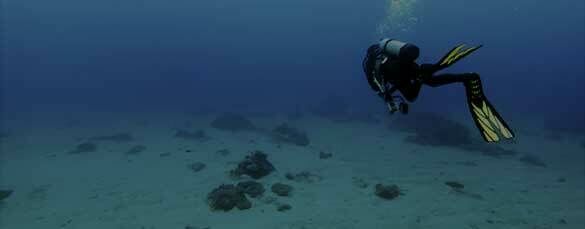Ophthalmological problems
Underwater Refractive Correction
The two choices that can be made are contact lenses and prescription face masks. If contact lenses are to be worn, soft contact lenses are to be preferred. Hard contact lenses have been shown to cause corneal oedema during decompression and after dives [1-4]. These changes are caused by the formation of nitrogen bubbles in the precorneal tear film which interfere with normal tear film physiology and result in epithelial oedema. With soft contact lenses which do not appear to cause corneal oedema [1,5], the most frequent complication is loss of the lens, which can be minimised by making sure that the mask fits well. This problem may be ameliorated to a certain extent by using the disposable “one day” soft lenses and carrying an extra pair of lenses on board the boat or in the diving kit bag.
Prescription face mask lenses provide the other alternative. These can be expensive, especially if the wearer has a degree of astigmatism. A face mask with corrective lenses bonded onto the face plate of the mask is also a possiblility, but may present problems with eventual erosion of, or bubble formation in the bonding substance used.
Ocular Barotrauma
Unless the diver expels gas through the nose into the face mask on descent, a relative negative pressure develops in the air space between the face plate and the face. Marked lid oedema and ecchymosis together with subconjunctival haemorrhage may result. The effects can be disconcerting, but usually resolve without sequelae. Overpressure is generally not a problem as the air escapes around the face mask seal.
Barotrauma may also occur in patients who dive with intraocular gas bubbles in the anterior chamber or vitreous cavity. Pressure-induced changes in the volume of this bubble may result in retinal, uveal, or vitreous haemorrhage, as well as partial collapse of the globe. Diving with any trace of an intraocular gas bubble is therefore contraindicated.
Ophthalmic Decompression Illness
It is worth remembering that the first observations of decompression illness were made by Robert Boyle in 1670 when he observed gas bubbles in the anterior chamber of the eye of a viper which had been experimentally exposed to decreased pressure [6]. Although ophthalmological manifestations of DCI are fairly rare, they may include nystagmus, diplopia, visual field defects, scotomas, and homonymous hemianopias. Fluorescein angiography studies of divers have documented retinal pigment epithelial abnormalities indistinguishable from those seen in eyes with choroidal ischaemia. These changes have been attributed to decompression-induced intravascular gaseous microemboli [7]. The incidence of these lesions was directly related to the length of diving and a history of DCI. No divers suffered a loss of visual acuity from these abnormalities, but the paper notes that the long-term effects of this phenomenon remain to be studied.
Retrochiasmal defects such as hemianopia or cortical blindness are potential ocular manifestations of DCI caused by arterial gas embolism, the commonest cause of which is pulmonary barotrauma.
Treatment of DCI is by prompt recompression.
Decreased Vision after Diving
The following causes should be considered:
- DCI
- Corneal oedema (hard lens users)
- Loss of a lens (soft lens users)
- Antifog keratopathy (resulting from the volatile compounds used in mask antifogging preparations)
- Ultraviolet keratitis
- Contact lens adherence syndrome (contact with sea water can cause soft lenses to become tightly adherent to the cornea).
Diving After Eye Surgery
Diving after eye surgery can only be carried out after a suitable time for the wound to heal. A number of factors will increase the risk of post-operative complications:
- The water in which diving is performed may harbour pathogens which can infect non-epithelialised surfaces.
- Such pathogens may enter the eye through non-healed wounds and result in vision-threatening endophthalmitis.
- Gas in the eye resulting from surgery can be affected by changes in pressure and this can give rise to vision-threatening intraocular barotrauma.
- Face mask barotrauma may result in subconjunctival haemorrhage and might cause rupture of incompletely healed wounds.
Unfortunately, there are as yet no controlled studies on the length of time a subject should not dive after different forms of ophthalmic surgery. Therefore the following comments are based on current “best practice”:
Corneal surgery: Studies on the rate of full thickness corneal scar healing show little healing in the first week, followed by a rise to approximately 50% of normal by 3-6 months. Procedures such as penetrating keratoplasty should be followed by a lay-off period of 6 months before being allowed to return to diving. Patients who have undergone radial and astigmatic keratotomy which do not involve prolonged steroid therapy, may be allowed to dive after a 3 month rest period. Photorefractive keratotomy in which there are no incisions may allow a return to diving as soon as re-epithelialisation of the cornea is complete and the acute post-operative symptoms subside.
Cataract surgery: A three month wait before resuming diving will generally be sufficient after extracapsular cataract surgery. Scleral tunnel incisions as used in phacoemulsification procedures will require a period of one month off diving to allow for healing to take place.
Glaucoma
Glaucoma may be treated either medically or surgically to reduce the intraocular pressure. Therefore, there may be concern when it is realised that diving may raise the intraocular pressure to very high levels. However, saturation divers working at depths of 250 metres have intraocular pressures in excess of 19,000 mm Hg without suffering from symptoms of glaucomatous optic neuropathy. Thus, it appears to be the magnitude of the difference between the extraocular and intraocular pressures that is important and during diving this difference should be very low. There are two possible complications that may arise in patients that undertake diving after glaucoma filtering surgery. These are a). subconjunctival haemorrhage due to face mask squeeze and chemosis that may compromise the operation of the filter and b). late endophthalmitis as a result of pathogens gaining access to the anterior chamber through the conjunctiva. In practice, neither of these complications has been reported as a complication of diving. A two month lay-off period is advised after this form of surgery and patients should be advised to avoid face mask barotrauma.
Further Reading
Butler FK. “Diving and hyperbaric ophthalmology” Surv.Ophthalmol. 39(1995)347-66.
References
Cotter J. “Soft contact lens testing on fresh water SCUBA divers” Contact Lens 7(1981)323-6.
Josephson JE, Caffery BE. “Contact lens considerations in surface and subsurface aqueous environments” Optom.Vis.Sci. 68(1991)2-11.
Socks JF, Molinari JF, Rowley JL. “Rigid gas permeable contact lenses in hyperbaric environments” Am.J.Opt.Phys.Optics 65(1988)942-5.
Edmonds C, Lowry C, Pennefather J. “Diving and subaquatic medicine” Oxford, Butterworth-Heinemann 1992 3rd ed. Chap. 30, p408.
Simon DR, Bradley ME “Adverse effects of contact lens wear during decompression” JAMA 244(1980)1213-4.
Boyle R. “A digressive experiment concerning the expansion of bloud and other animal juyces” Phil.Trans.Roy.Soc.Lond. 63(1670)2033-44.
Polkinghorne PJ, Cross MR, Sehmi K et al. “Ocular fundus lesions in divers” Lancet (1988)1381-3.
Rashid ER, Waring GO. “Complications of radial and transverse keratotomy” Surv.Ophthalmol. 34(1989)73-106.



